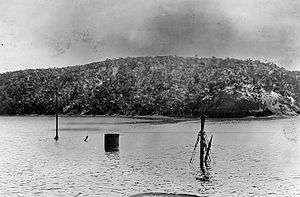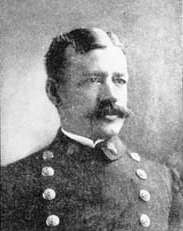USS Merrimac (1894)
 USS Merrimac | |
| History | |
|---|---|
| Name: |
|
| Namesake: | Merrimack River |
| Port of registry: | |
| Builder: | Swan & Hunter, Wallsend |
| Yard number: | 194 |
| Completed: | November 1894 (as Solveig) |
| Acquired: | 12 April 1898 |
| Commissioned: | 11 April 1898 |
| Fate: | Sunk, 2 June 1898 |
| General characteristics | |
| Type: | steamship |
| Displacement: | 3,362 long tons (3,416 t) |
| Length: | 322 ft 9 in (98.37 m) |
| Beam: | 44 ft 2 in (13.46 m) |
| Depth: | 27 ft 3 in (8.31 m) |
| Propulsion: | 1 × triple-expansion steam engine |

USS Merrimac was a United States Navy collier during the Spanish–American War. It was the only American vessel sunk by the Spanish navy in that conflict.
Merrimac, a steamship, was built by Swan & Hunter shipyard as SS Solveig in Wallsend, England, in November 1894. She was purchased by the US Navy in April 1898. Rear Admiral William T. Sampson ordered her to be sunk as a blockship at the entrance of Santiago Harbor, Cuba, in an attempt to trap the Spanish fleet in the harbor. On the night of 2–3 June 1898, eight volunteers attempted to execute this mission, but Merrimac's steering gear was disabled by the fire of Spanish land-based howitzers. The American steamer was later sunk by the combined gunfire and the torpedoes of the armored cruiser Vizcaya,[1] the unprotected cruiser Reina Mercedes, and the destroyer Plutón[2] without obstructing the harbor entrance. Her crewmen were rescued by the Spanish and made prisoners-of-war.[3] After the Battle of Santiago de Cuba destroyed the Spanish fleet a month later, the men were released. All eight were awarded Medals of Honor for their part in the mission.[4]
The eight volunteer crewman of the Merrimac were:
- Lieutenant Richmond P. Hobson
- Coxswain Claus K. R. Clausen
- Coxswain Osborn W. Deignan
- Coxswain John E. Murphy
- Chief Master-At-Arms Daniel Montague
- Gunner's Mate First Class George Charette
- Machinist First Class George F. Phillips
- Watertender Francis Kelly

Richmond Hobson 
Claus Clausen 
Osborn Deignan .jpg)
John E Murphy .jpg)
Daniel Montague 
George Charrette 
George F Phillips .jpg)
Francis Kelly
Notes
- ↑ The Boys of '98, By James Otis
- ↑ "What Hobson and his own men could not do by means of their own torpedoes, the Spaniards did with theirs, for they launched several from the Mercedes and the Pluton which gave the coup de grace, sinking the Merrimack just off Socapa Point." Wiley, Edwin and Everett Rines, Irving (1915). Lectures on the growth and development of the United States, Volume 10. American Educational Alliance, p. 126
- ↑ Hobson, p. 90
- ↑ Hobson, p. xxiv
References
- Sinking of the U.S. Navy Collier Merrimac
- Hobson, Richmond Pearson (1899). The Sinking of the Merrimac. Classics of Naval Literature. Naval Institute Press. ISBN 0-87021-632-5
- This article incorporates text from the public domain Dictionary of American Naval Fighting Ships. The entry can be found here.
- "US People – Montague, Daniel, Chief Boatswain". Naval Historical Center. 2006-05-03. Retrieved 2006-12-02.
Coordinates: 19°58′37″N 75°52′18″W / 19.97694°N 75.87167°W